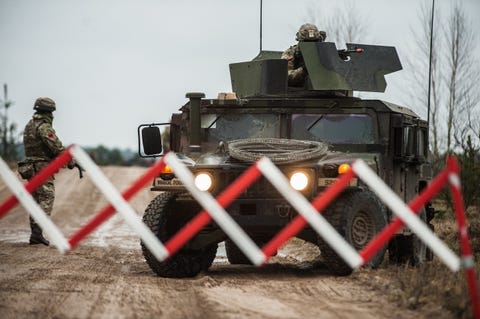High-Powered Microwave Ray Gun Can Stall Cars, Trucks
The Radio Frequency Vehicle Stopper sends pulses of microwave radiation to disable vehicles.
By Kyle Mizokami
U.S. ARMY
The Pentagon’s Joint Non-Lethal Weapons Program (JNLWP) is set to take possession of a new weapon system that can stop cars and trucks in their tracks.
The Radio Frequency Vehicle Stopper bombards a target with high-powered microwave radiation, interfering with a modern car’s electronics and bringing it to a stop. The system is particularly useful in light of recent attacks against civilians using vans and trucks as weapons.
As DefenseOne explains, “The jammer works by targeting the car’s engine control unit causing it to reboot over and over, stalling the engine. Like an invisible hand, the microwaves hold the car in place." David Law, who leads JNLWD’s technology division, said in March: “Anything that has electronics on it, these high-powered microwaves will affect. As long as the [radio] is on, it holds the vehicle stopped.”
A 2012 Defense Technical Information Center document, “Multifrequency Radio-Frequency (RF) Vehicle Stopper (PDF)” describes the technology behind the system:
“The RFVS system uses high-power magnetron tubes to generate intense RF pulses that interfere with a vehicle’s electronics, rendering it temporarily inoperable. The engine cannot be restarted while the RF is on but is readily restarted once the RF is turned off. Thus, the RFVS system allows for the maintenance of a safe keep-out zone in situations that might otherwise require the use of lethal force. The defined measure of success for this system is a demonstrated, effective capability against more than 80% of the candidate target-vehicle-class list, which includes passenger cars and large vehicles.”
The article goes on to say that a non-lethal weapon that uses on microwave radiation to attack an electronic target must use multiple microwave frequencies; the radiation must attack critical electronic components inside the target to be effective, and different components are vulnerable at different frequencies.

U.S. and Polish troops practice deploying a military checkpoint.
DOD/COURTESY PHOTO TAKEN BY MARCIN SWIDZINSKI
The RFVS was originally designed for force protection purposes, stationing them at vehicle checkpoints to stop confused civilians or, worse, suicide bombers driving cars. Shooting at civilian vehicles to force them to stop is extremely dangerous to the civilians. Small arms fire from weapons such as a M4A1 carbine are also unreliable as a means of stopping cars, as the number of shots necessary to stop them varies greatly. RFVS can reliably stop vehicles in both instances.
As DefenseOne points out, the microwave vehicle stopper could also be useful against attackers using vans and trucks against civilians. Regular police units do not have the heavy weaponry to guaranteed stop a large vehicle, nor should they necessarily have them. A microwave weapon that stops the vehicle dead in its tracks would be a more acceptable alternative that minimizes the danger to civilians.
DefenseOne notes the JNLWP is set to take receive two versions of the weapon, one that fits in the back of a truck with a range of 50 meters and another three times larger with a range of “a few hundred meters.”
No comments:
Post a Comment